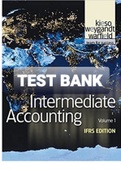,To download more slides, ebook, solutions and test bank, visit http://downloadslide.blogspot.com
CHAPTER 1
Financial Reporting and Accounting Standards
ASSIGNMENT CLASSIFICATION TABLE
Topics Questions Cases
1. Global markets. 1
2. Environment of accounting. 2, 3, 4 4, 5, 7
3. Objective of financial reporting. 5, 6, 7, 8, 9, 10 2
4. Standard-setting organizations. 11, 12, 13, 14, 1, 3, 6
15, 16, 17, 18
5. Financial reporting challenges. 19, 20, 21, 22, 8, 9, 10
23, 24, 25
6. Ethical issues. 26 11, 12, 16
*7. Authoritative U.S. pronouncements 27, 28, 29, 30, 31, 13, 14, 15
and policy-setting bodies. 32, 33, 34, 35, 36,
37, 38
*These questions and cases address material in the appendix to the chapter.
Copyright © 2011 John Wiley & Sons, Inc. Kieso, IFRS, 1/e, Solutions Manual (For Instructor Use Only) 1-1
, To download more slides, ebook, solutions and test bank, visit http://downloadslide.blogspot.com
ASSIGNMENT CHARACTERISTICS TABLE
Level of Time
Item Description Difficulty (minutes)
CA1-1 IFRS and standard-setting. Simple 5–10
CA1-2 IFRS and standard-setting. Simple 5–10
CA1-3 Financial reporting and accounting standards. Simple 15–20
CA1-4 Financial accounting. Simple 15–20
CA1-5 Need for IASB. Simple 15–20
CA1-6 IASB role in standard-setting. Simple 15–20
CA1-7 Accounting numbers and the environment. Simple 10–15
CA1-8 Politicalization of IFRS. Complex 15–20
CA1-9 Models for setting IFRS. Simple 10–15
CA1-10 Economic consequences. Moderate 25–35
CA1-11 Rule-making Issues. Complex 20–25
CA1-12 Financial reporting pressures. Moderate 25–35
*CA1-13 GAAP terminology. Moderate 20–30
*CA1-14 Accounting organizations and documents issued. Simple 3–5
*CA1-15 Accounting pronouncements. Simple 5–7
CA1-16 GAAP and economic consequences. Moderate 25–35
1-2 Copyright © 2011 John Wiley & Sons, Inc. Kieso, IFRS, 1/e, Solutions Manual (For Instructor Use Only)
, To download more slides, ebook, solutions and test bank, visit http://downloadslide.blogspot.com
ANSWERS TO QUESTIONS
1. World markets are becoming increasingly intertwined. The tremendous variety and volume of both
exported and imported goods indicates the extensive involvement in international trade. As a
result, the move towards adoption of international financial reporting standards has and will continue
in the future.
2. Financial accounting measures, classifies, and summarizes in report form those activities and that
information which relate to the enterprise as a whole for use by parties both internal and external
to a business enterprise. Managerial accounting also measures, classifies, and summarizes in report
form enterprise activities, but the communication is for the use of internal, managerial parties, and
relates more to subsystems of the entity. Managerial accounting is management decision oriented
and directed more toward product line, division, and profit center reporting.
3. Financial statements generally refer to the four basic financial statements: statement of financial
position, income statement, statement of cash flows, and statement of changes in equity. Financial
reporting is a broader concept; it includes the basic financial statements and any other means of
communicating financial and economic data to interested external parties.
4. If a company’s financial performance is measured accurately, fairly, and on a timely basis, the right
managers and companies are able to attract investment capital. To provide unreliable and irrelevant
information leads to poor capital allocation which adversely affects the securities market.
5. The objective of general purpose financial reporting is to provide financial information about the
reporting entity that is useful to present and potential equity investors, lenders, and other creditors
in making decisions in their capacity as capital providers.
6. General purpose financial statements provide financial reporting information to a wide variety of
users. To be cost effective in providing this information, general purpose financial statements provide
at the least cost the most useful information possible.
7. Shareholders, creditors, suppliers, employees, and regulators all use general purpose financial
statements. The primary user group is capital providers (shareholders and creditors).
8. The proprietary perspective is not considered appropriate because this perspective generally does
not reflect a realistic view of the financial reporting environment. Instead the entity perspective
is adopted which is consistent with the present business environment where most companies
engaged in financial reporting have substance distinct from their investors.
9. The objective of financial reporting is primarily to provide information to investors interested in
assessing the company’s ability to generate net cash inflows and management’s ability to protect
and enhance the capital providers’ investments. Financial reporting should help investors assess
the amounts, timing and uncertainty of prospective cash inflows.
10. A single set of high quality accounting standards ensures adequate comparability. Investors are
able to make better investment decisions if they receive financial information from a U.S. company
that is comparable to an international competitor.
11. The two organizations involved in international standard-setting are IOSCO (International Organi-
zation of Securities Commissions) and the IASB (International Accounting Standards Board.) The
IOSCO does not set accounting standards, but ensures that the global markets can operate in an
efficient and effective manner. Conversely, the IASB’s mission is to develop a single set of high
quality, understandable and international financial reporting standards (IFRSs) for general purpose
financial statements.
Copyright © 2011 John Wiley & Sons, Inc. Kieso, IFRS, 1/e, Solutions Manual (For Instructor Use Only) 1-3





